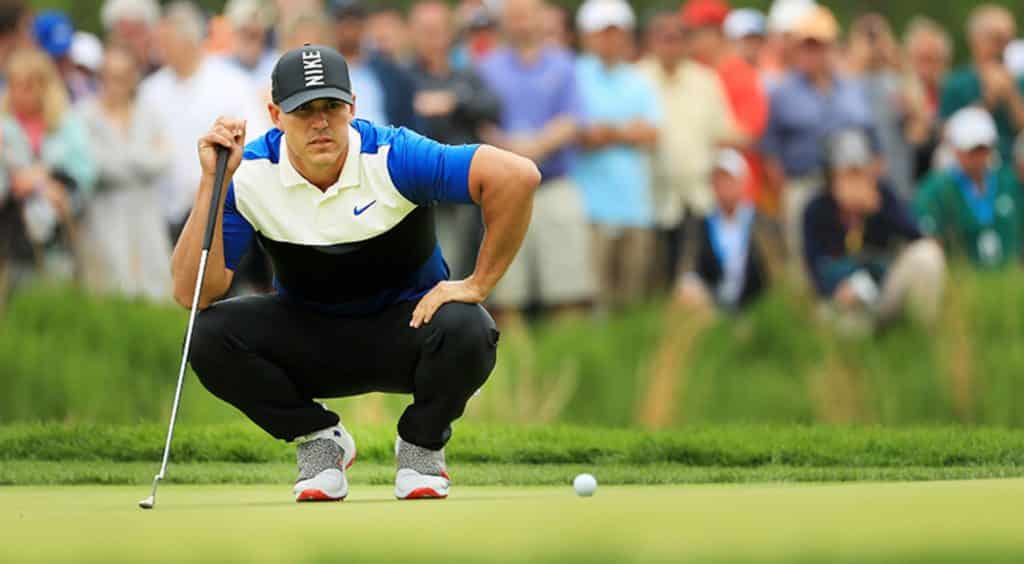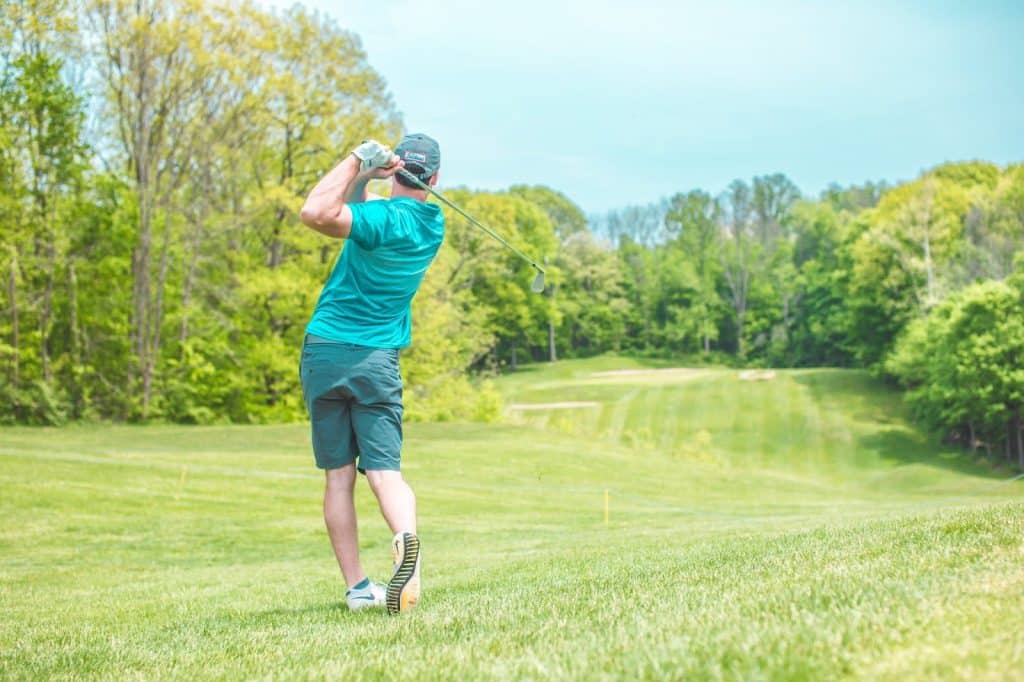Golf is undoubtedly one of the hardest, most frustrating games on the planet.
Tiny errors in judgement and coordination, such as early extension, hip slide or simply improper swing feel, can lead to massive mistakes on the course.
The old adage ‘practice makes perfect’ does apply to golf, but only if you are practicing properly.
So how often should you practice golf in order to get better?
Practicing four times per week at the range, chipping area and putting green will help you become a better golfer. Focus on specific drills, and practice with purpose. Getting lessons with a qualified instructor will also give you the proper guidance needed to improve your game fast.
You can obviously practice more or less than that if you wish, but hitting the range, practice green or chipping area multiple times every week is the best way to see quick progress.
Let’s delve deeper into how you should practice golf.
Table of contents
How many days a week should I practice golf?
If you want to get better at golf, you should practice as much as your schedule and body allows. The more you practice each week – whether it’s your long game, short game or putting – the faster you will improve. But, you must listen to your body and not overdo it, otherwise you risk injuring yourself.
If you are struggling with something like tennis elbow (which can sometimes be resolved by wearing a brace) then golfing six days a week will likely aggravate this, so a better management plan would be recommended.
If your body is strong, you have no back or knee issues, you have the time and love the range, 100 balls every day will certainly see you improve quickly.
For people who live busy lives, have kids and find hitting the range hard to squeeze into their schedule, two sessions a week (one long game and one short game) is potentially the sweet spot for any moderately serious golfer.
However, if you have major swing flaws and find that your practice session consists of fat and thin shots and shanks left and right, it’s likely that practice is merely messing with your head and further embedding a poor technique into your muscle memory.
They key here is good practice. The more good practice you do, the better.
I practice. Why am I not getting better at golf?
No matter how much you practice, if your technique is poor you are unlikely to get better at golf. Most average golfers can reach a handicap in the high teens through dedication, practice and general hand-eye coordination and sporting ability. But to break through this barrier often requires professional help from a qualified PGA instructor.
Those who continue to go it alone are likely destined to ‘max out’ at the 16-handicap mark, which is the average golf handicap worldwide.
If you feel like you practice regularly, are committed, but just can’t get better, trying a lesson with a professional might just be the remedy.
Another reason why people do not improve at golf is they neglect the weak areas of their game when they practice.
Most people find hitting driver or 9-iron off a tee fairly forgiving and a range session may consist of 50-60 of these comfortable shots.
Transition to the 4-iron off the deck, catch a few thin and many people will rush to put it back in the bag and reach for the easier to hit 7-iron instead.
Ask many average golfers where the short game practice area is at their local range and you may be met with a blank stare.
There’s a reason why players struggle with long irons, bunker shots and putting: they simply don’t practice them.
If you have weaknesses in your game, when you practice, these should be the first on your list.
Is it better to practice or play golf?
It is best to divide your time practicing and playing golf. Your time spent practicing should be used to improve specific weaknesses in your game, which you can then test on the course. This is the only way you will reduce your handicap and learn to cope with on-course pressure.
There are many types of golfer when it comes to practice.
Some prefer to grind it out on the range, hitting ball after ball in preparation for their one big game a week on Saturday, while others despise the range, needing the motivation of a score and competition to bring enjoyment to their practice.
While everyone is different, there’s no denying that a combination of the two is really important.
Range sessions are necessary to practice and hone particular parts of your game through repetition.
While it is rare that you’d ever hit three 7-irons in a row in a game, if you’re trying to incorporate a new swing thought into your iron play, you need some reoccurring feedback to inform you whether you’re getting things right.
Despite this, range sessions aren’t everything, and if you don’t have low stakes practice rounds on the course, you’ll be neglecting a key area for improvement.
On the range, how many times do you practice a 120-metre punch shot? A left-handed shot up against a boundary fence? A sideways chip that doesn’t run through the other side of the fairway?
If the answer is anything other than zero then you’re more committed than I, and the majority of golfers out there.
On course practice puts you in situations you never find, or put yourself in, on the range.
The key here is to make sure these situations occur enough during practice rounds where the score doesn’t matter, allowing you to drop a second ball down and have another go if needed.
If you don’t like practicing on-course alone, bring a mate along and enjoy a few beers while you’re walking the fairways. Golf is a social sport, after all.

Is it bad to practice on golf mats?
Practicing on golf mats won’t give you anywhere near as accurate feedback as practicing on grass. The firmness of golf mats tends to bump the club into the back of the ball on fat shots. This can give the golfer the false impression they’ve struck the ball well, when in reality they haven’t.
But, more often than not, the vast majority of driving ranges out there will have golf mats – the artificial turf squares that are designed to replicate a fairway – rather than grass.
These mats are used purely for wear and tear purposes, as grass used hundreds of times a day will deteriorate very rapidly, not to mention cost a lot to maintain.
These mats are a sufficient playing surface to practice from, but there are a few things to be mindful of.
Generally, these mats are more forgiving when it comes to ‘fat’ shots, as your club won’t dig into the turf if you hit behind the ball.
The clubhead will bounce or skid off the hard surface and sometimes catch your ball relatively well.
There are a couple of things you can do to watch for this:
Keep an eye on your distances
- It is important to remember that range balls will fly shorter distances than a premium golf ball, so a 7-iron that ‘felt good’ but only went 105 metres was likely caught heavy.
Consider using a strip of masking tape behind the ball
- It won’t damage the mat and if you are disturbing the tape, you’ll be able to tell quickly whether you are getting the ground first. It’s also pretty inconspicuous so you won’t feel like a goose on the range either.
Ultimately, range mats are fine, but it is recommended to try and find a practice facility with a grassed area to hit off of every now and then to properly replicate course conditions.
Also, regardless of whether you are hitting off mats or grass when at the range, we’d highly recommend you look into purchasing an alignment stick.
They aren’t expensive but can make a huge difference to your practice session by removing any doubt over where you’re aiming – all you need to do is place it on the ground parallel to your target line, and you’re good to go.
How often do the pros practice?
Some professional golfers practice their full swing for up to three hours every day, and spend an equal amount of time on their short game. Each player has their preferences, however – for example, Tiger Woods is famous for his relentless practice sessions, while John Daly is renowned for barely practicing at all.
Although it is utterly ridiculous to do so, we just can’t stop ourselves drawing comparisons between us and the pros.
We forget that Woods and Daly, despite their different physical figures, are athletes who aren’t working a desk job 40 hours a week.
We have to remember that this is their job, and through sheer weight of hours and commitment, professional golfers are able to reach heights most of us can only dream of.
The best in the world spend several hours a day on their long game, short game, putting, fitness, strength and even mental game – a level of commitment your average 20-handicapper will never replicate.
Interestingly enough, though, there is one area where any golfer actually can match it with the pros: short game.
One sure fire way to slash strokes from your scorecard in no time is to chip and putt like your life depends on it (even if it means buying a chipper to fix your short game and get up and down more often).
Reading a green is about developing feel. Judging pace is about developing touch.
Any average golfer who commits to a regime of rolling over a spot in the loungeroom or chipping into a garden bed in the yard may actually stand a chance of matching it with the big boys in one aspect of the game.
Summary
Here are the main dos and don’ts of golf practice:
DO
- Practice both on the range and on the course to focus on small tweaks and obscure shots respectively, as well as dealing with pressure.
- Practice at least once a week, preferably twice, so long as your body can tolerate it.
- Practice those areas of your game where you are weak.
- Have a practice session every couple of weeks on a grassed range. The divots you make give you excellent feedback. Failing this, watch for distance or use tape on an artificial mat.
- Consider getting help from a coach if your practice does not seem to work. Some pros are better than others, so you may need to try a few before finding one that suits.
- Be realistic. You’ll never drive the ball like Brooks Koepka. But you could putt like him.

DON’T
- Overdo it. If you have tennis elbow or a bad back, save yourself for the fun part: the weekend round with friends.
- Spend all of your time on the parts of the game you are good at. You won’t get better unless you address the weaknesses.
- Neglect putting and short game.
- Purely practice on the range.
- Go it yourself if you just can’t get better. It can be pricey, but a good coach could change your life.
Final message
The king of golf Arnold Palmer perhaps summed the game up best when he said “Golf is deceptively simple and endlessly complicated; it satisfies the soul and frustrates the intellect.
It is at the same time rewarding and maddening – and it is without a doubt the greatest game mankind has ever invented”.
If golf was easy, everyone would play it. It is because it is hard that we become obsessed with the game and one of the toughest improvement journeys one can ever hope to embark on.
By following some of our simple tips, you may just get one step closer to mastering the game so few can.
- TaylorMade SIM2 Max Driver vs M4 Driver: Worth it in 2024? - April 15, 2024
- 3 Ways to Win the Mental Game with the Bridgestone Mindset Golf Ball - March 29, 2024
- TaylorMade SIM Max & SIM2 Max Drivers: Are they Still Relevant in 2024? - March 9, 2024


